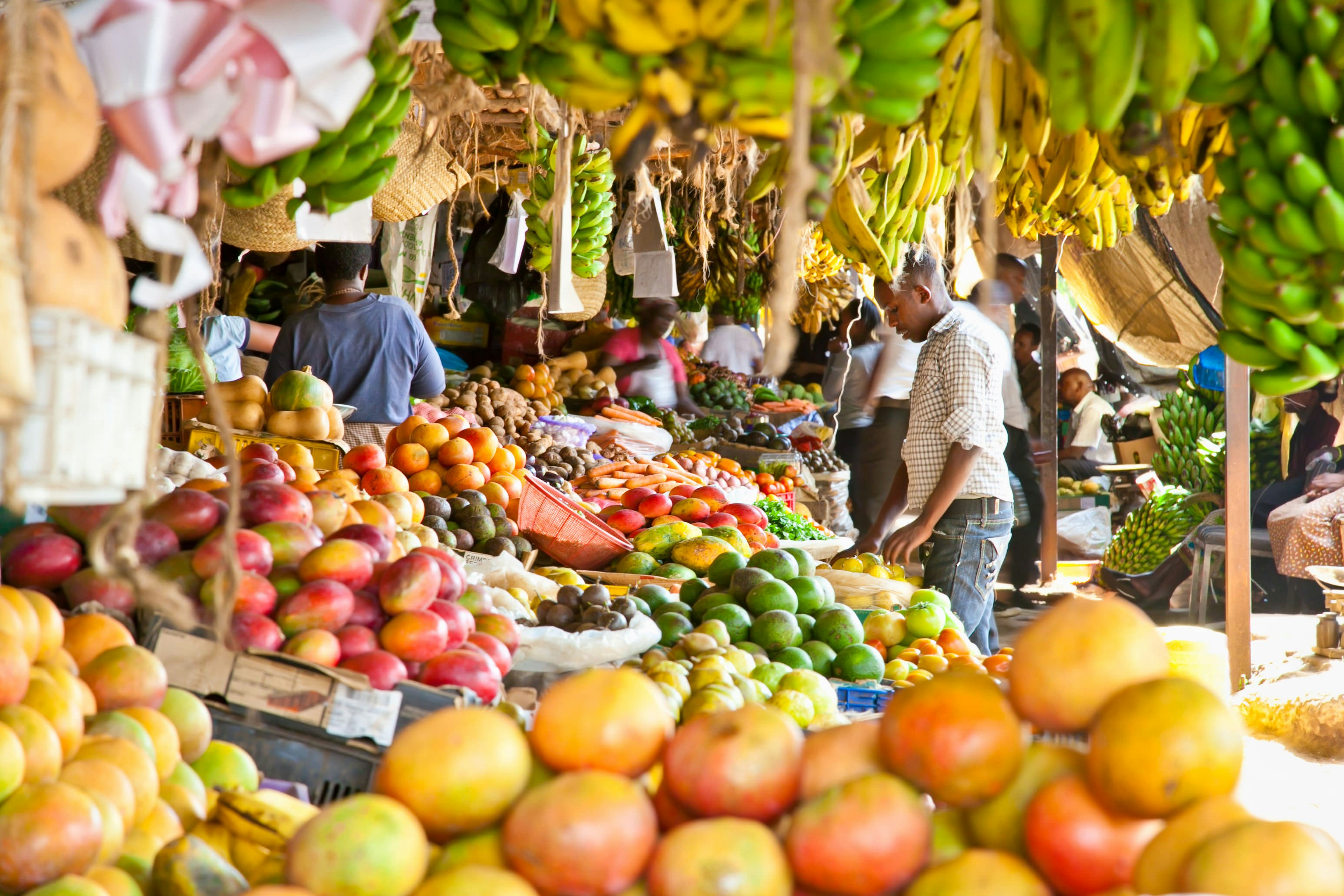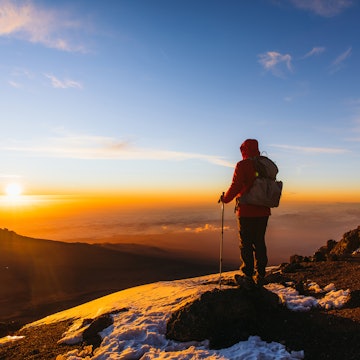

Camping in national parks is an excellent way to stretch your budget in Kenya © PeopleImages.com - Yuri A / Shutterstock
Kenya is not generally considered an expensive place to travel, but its developed tourist industry means prices can be a little higher than other African countries.
If you plan to see a lot of this beautiful nation, costs can add up – especially if you want to go on safari. While luxury lodges have come to symbolize the safari experience in tourism campaigns and glossy magazines, there are plenty of alternatives – you can camp, opt for midrange accommodations, stay with a local community or travel off-season.
With a wide choice of hotels, apartments and restaurants, Nairobi has options for every budget. Eating street food and using low-cost transportation will also save you money. Beach resorts span the price spectrum, too, from 5-star luxury and stylish, staffed villas to beach bungalows and cut-price boutique hotels. Here’s how to visit Kenya on a budget.
1. Compare direct and indirect flights
Indirect flights to Kenya are often cheaper, so consider flying into other African hubs, such as Addis Ababa in Ethiopia or Johannesburg in South Africa, to see how much you can save. Excellent deals are not uncommon, and a number of African carriers have frequent flights into Nairobi.
If you’re traveling from the west coast of North America, you could also consider flying via Southeast or East Asia. Set up flight alerts on sites like Skyscanner or Google Flights to get a notification when the route and dates you’ve chosen see a price drop. It’s worth signing up for airline newsletters such as the one from Kenya Airways, which often publicizes exclusive offers within a specified time period.
2. Hop on the bus or take an Uber from the airport
If you’re landing in Nairobi, use the free airport wi-fi to log into Uber. Fares via the app are up to a third cheaper than those charged by official airport taxis – typically KSh2000 to the city center. Alternatively, take the airport bus (number 34), which costs KSh35 from outside Terminal 1.

3. Book a car with a driver for multi-stop itineraries
Hiring a private car and driver is an affordable and fun way to travel around Kenya, particularly for groups, as it gives you the freedom to stop off at viewpoints, roadside cafes and anywhere else you want. Arrange hire with a local travel agent or at your accommodation, but make sure you confirm the day rate. This can vary depending on the vehicle, distances and terrain, but it works out to around KSh6000 a day, plus the cost of any extras, such as gas and money for the driver’s meals and accommodations.
Some lodges and hotels will have their own accommodations for drivers, but it’s not always the best quality, so be responsible and ethical by asking what they offer in advance (directly or through your tour operator). If it’s not up to scratch, add another KSh1500 to KSh6000 to the day rate so the driver can find their own accommodation. They’re usually familiar with the area.
4. Travel during Kenya’s shoulder seasons
There are several ways to save money if you’ve got the flexibility to travel outside of Kenya’s busiest tourist periods, typically July to October and January and February, after the short rains. International flights and accommodations will both cost a little less, and if you travel outside of the Great Migration (July to October), you can also pick up good deals for the Masai Mara, which is fantastic pretty much any time of year. For a cheaper safari, book between the short and long rains (January to March) when prices are usually lower than during the peak vacation season.
Beach resorts and hotels offer great deals outside the peak periods too. Shop for bargains in October and November or before the rains in March and April. Traveling in the rainy season can also be a winner as the downpours are often short-lived, the landscapes are lush, and the price difference can be significant.
5. Avoid domestic flights in favor of slow travel
Domestic flights are fairly reasonable in Kenya – costing around KSh7500 for a one-way from Nairobi to Mombasa or other coastal destinations such as Malindi. But it's cheaper and more eco-conscious to travel by long-distance bus, with equivalent fares of around KSh1600. For a slower, even more sustainable journey, take the train. Routes are limited, but Nairobi to Mombasa only costs KSh1000 in economy class and KSh3000 in first class.
6. If you have to fly, book in advance
Despite a growing number of carriers, popular domestic routes still get fully booked. Buy flights in advance to get lower fares and secure the days and times you wish to travel. Airlines differ in when they release new tickets, so book as soon as you know your dates – flights are often either non-refundable or not easily changed.

7. Try street food and korogas
Kenya has a flourishing restaurant scene, but street food and cafes can be a great way to eat well and save money – it’s hard to resist roadside snacks like freshly grilled corn on the cob, nyama choma (roasted meat), and grilled matoke (plantain). Kenyans will also head to restaurants that specialize in koroga (barbecue) to share large, good-value platters of meat, tawa (griddled) dishes, and pizzas cooked on a jiko (charcoal-burning stove).
8. Don’t dismiss the hostels
Hostels across the world have modernized in the last few years and Kenya is no exception. It’s now standard for dorm rooms to have beds with privacy curtains, personal plug sockets, USB points and reading lights. Many also offer private rooms with en-suite bathrooms.
Kenyan hostels are often cheaper than their hotel equivalent, with many new or recently refurbished establishments offering better quality private rooms than some midrange hotel options. A few standouts include the award-winning eco-hotel Distant Relatives above Kilifi's lagoon, sustainable eco-accommodation Kobi Farm on the border of the Masai Mara National Reserve, and Wildebeest Eco Camp, which has everything from deluxe tents to dorm beds in Nairobi.
9. Go camping
The cheapest way to stay inside Kenya's national parks is to camp. Sleeping under the stars can be a magical experience, especially as most parks have showers, restaurants and bars, too. Rates vary but expect to pay anything upwards of KSh1300 a night with your own tent and bedding, or around KSh2500 for a pre-constructed tent. It's around KSh6500 if you want cooked meals included too. Kenya Wildlife Service lists the amenities for each park. Because they’re much cheaper, they’re also popular – book ahead, especially in the high/dry season.
10. Stay outside the national parks
Lodges and accommodations inside national parks usually come with a hefty price tag. If you’re looking to save shillings, book a safari lodge or hotel located just outside the park’s boundaries (but not too far if you’re planning an early-morning game drive). For cheaper digs, check out village stays or camps aimed at backpackers (even if you aren’t one). As well as pitches for tents, many offer pre-pitched tents or cabins.

11. Book a beach villa with a chef (honestly)
Accommodation with its own cook might sound indulgent, but renting a private house or villa along the Indian Ocean coast or the Lamu Archipelago has become increasingly popular. Costs vary depending on the quality of the property, the location, and the facilities, but you can often rent a 5-star, luxury property for around half the price you’d pay for a hotel of equivalent standard.
Most properties are staffed with a chef and housekeeping. With such delicious, fresh ingredients in Kenya, this is an affordable way to dine like royalty (while also saving on eating out each night). You can request meals or ask the chef to cook their own specialties for little more than the price of a grocery store shop. We recommend tipping at the end of your stay, even if service is included in the rental cost.
12. Plan your itinerary carefully…
You can save a lot – and avoid unnecessary travel – by planning your trip carefully. Many of Kenya's best things to do are spread out across the country, so unless you’ve got plenty of time and money, trying to visit Lake Turkana in the north, then Lamu Island and Tsavo National Park in the southeast in a single trip just isn’t feasible.
13. …and add in time for Nairobi
Whatever your proposed itinerary, factor in a few days in Nairobi. The often-overlooked capital is a great place for anyone on a budget – you can always find a good hotel deal, there’s a wide choice of restaurants and bars, and if a safari trip is out of the question, you can always head to Nairobi National Park for the day. It’s the only national park in the world located inside a city.

14. Book your safari when you’re in Kenya
Unless you’re staying at high-end lodges, Kenya is actually an affordable safari destination with a wide selection of mid-range lodges, eco-camps, community village stays, and hotels. If safari lodges aren’t as full as expected or if it’s low or shoulder season, you can pick up excellent packages that include transport, meals, guides and game drives for half the expected cost.
This doesn’t necessarily mean booking directly. Local travel agents can often find stellar last-minute deals, but you can check out websites such as Safari Bookings, which brings together a wide range of operators offering budget (and luxury) safari packages that are bookable for the next day onward. They include trips for solo travelers too.
15. Don’t forget about national park admission fees
If you're traveling independently, don't forget to budget for National Park admission costs, which vary from park to park. For example, Nairobi National Park charges US$40 to non-residents for entry, while admission to the Masai Mara is US$80 for 24 hours if you are staying outside of the reserve and US$70 if you're staying inside.
16. Be mindful of the exchange rate
Don’t lose out by changing money in a rush. While rates are generally decent in banks and official money exchange bureaus, it’s always advisable to check the day’s exchange rate on an app such as xe.com to make sure what you’re getting is reasonable. If you’re en route to Tanzania and have leftover Kenyan shillings, you’ll get a more favorable exchange rate on the Tanzanian side of the border.
17. Barter a little, but not too hard
It’s standard to haggle a little in Kenya – with a smile – at markets and in certain shops like fabric or souvenir stores. Market stall holders may start with a higher price in the first place, and even expect good-natured haggling. Decide what you feel you want to pay, but don’t push it too low. Most sellers won’t accept a price they don’t want to sell at, so don’t haggle to the last shilling and always remain respectful.
Daily costs in Kenya
Dorm bed at a hostel: KSh1400–2200
Double room in a midrange or boutique hotel: KSh4000–20,000
Self-catering apartment (including Airbnb): from KSh7500
Three-day budget to mid-range safari package: KSh50,000–80,500
Public transport (matatu or minibus): KSh150–650
Uber across town: KSh160–800
Taxi with driver for sightseeing: from KSh3000 for a half-day
Admission to major attractions: KSh1200–3000
Coffee: KSh250–390
Sandwich or light cafe lunch: KSh380–900
Dinner for two: KSh1200–4000
Beer at a bar: KSh150–260














